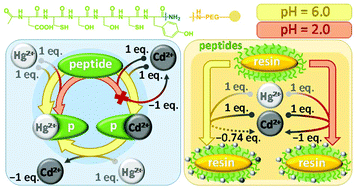Hg2+ and Cd2+ binding of a bioinspired hexapeptide with two cysteine units constructed as a minimalistic metal ion sensing fluorescent probe†
Abstract
Hg2+ and Cd2+ complexation of a short hexapeptide, Ac-DCSSCY-NH2 (DY), was studied by pH-potentiometry, UV and NMR spectroscopy and fluorimetry in aqueous solutions and the Hg2+-binding ability of the ligand was also described in an immobilized form, where the peptides were anchored to a hydrophilic resin. Hg2+ was demonstrated to form a 1 : 1 complex with the ligand even at pH = 2.0 while Cd2+ coordination by the peptide takes place only above pH ∼ 3.5. Both metal ions form bis-ligand complexes by the coordination of four Cys-thiolates at ligand excess above pH ∼ 5.5 (Cd2+) and 7.0 (Hg2+). Fluorescence studies demonstrated a Hg2+ induced concentration-dependent quenching of the Tyr fluorescence until a 1 : 1 Hg2+ : DY ratio. The fluorescence emission intensity decreases linearly with the increasing Hg2+ concentration in a range of over two orders of magnitude. The fact that this occurs even in the presence of 1.0 eq. of Cd2+ per ligand reflects a complete displacement of the latter metal ion by Hg2+ from its peptide-bound form. The immobilized peptide was also shown to bind Hg2+ very efficiently even from samples at pH = 2.0. However, the existence of lower affinity binding sites was also demonstrated by binding of more than 1.0 eq. of Hg2+ per immobilized DY molecule under Hg2+-excess conditions. Experiments performed with a mixture of four metal ions, Hg2+, Cd2+, Zn2+ and Ni2+, indicate that this molecular probe may potentially be used in Hg2+-sensing systems under acidic conditions for the measurement of μM range concentrations.



 Please wait while we load your content...
Please wait while we load your content...